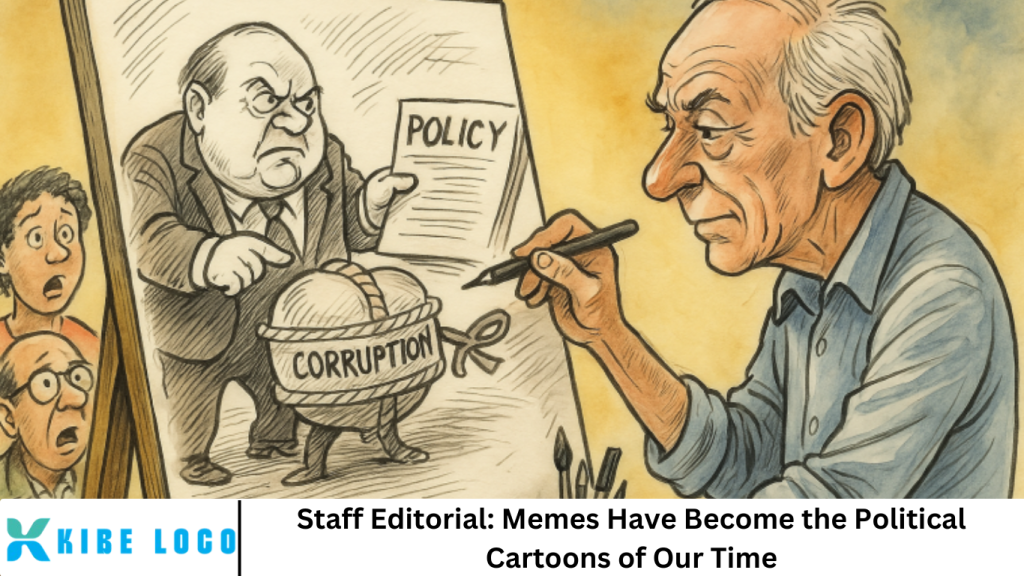In the fast-paced digital age, where information travels faster than ever, traditional forms of political commentary have evolved dramatically. What once was the exclusive realm of newspaper editorial pages—sharp, satirical political cartoons—has now transformed into a vibrant and viral landscape dominated by memes.
These digital snippets, often humorous and highly shareable, have emerged as the political cartoons of our time. This editorial explores how memes shape political discourse, engage younger generations, and reflect the social and political anxieties of today.
More Read: 13 Shows to Watch If You Love Game of Thrones and House of the Dragon
The Rise of Political Cartoons: A Brief History
Political cartoons have a rich history dating back centuries. They emerged as powerful tools for social critique, satire, and commentary on political events. In the 18th and 19th centuries, artists like James Gillray and Thomas Nast used caricature and symbolism to expose corruption, challenge authority, and provoke public debate.
These cartoons were published in newspapers and magazines, reaching a wide audience eager to engage with political issues through a blend of art and humor. Political cartoons thrived because they distilled complex ideas into memorable images that could quickly communicate a message.
Their satirical nature invited readers to question the status quo, making them a vital part of democratic societies. However, with the decline of print journalism and the rise of digital media, traditional political cartoons have seen a reduction in prominence.
Memes: The Digital Evolution of Political Satire
Enter the meme—a form of digital content that combines images, text, and sometimes video to convey a message in a succinct and often humorous way. While memes have existed in various forms for decades, their current prominence is largely due to social media platforms like Twitter, Instagram, TikTok, and Facebook.
These platforms allow rapid creation, sharing, and remixing of content, which helps memes spread virally. Much like political cartoons, memes use satire and humor to comment on current events, political figures, and social issues.
They provide a way for everyday people to express opinions, frustrations, and hopes without needing formal editorial approval. This democratization of political commentary is one reason memes resonate so strongly with younger generations, particularly Gen Z and Millennials.
Why Memes Resonate with Younger Generations
Younger generations grew up in an era dominated by digital technology and social media. Their attention spans are shorter, and they consume information differently than older generations. Memes fit perfectly into this new media environment for several reasons:
- Brevity and Impact: Memes deliver quick, impactful messages that are easy to understand and share.
- Relatability: They often use pop culture references, inside jokes, and current events to create content that feels relevant and personal.
- Community Building: Sharing memes creates a sense of belonging among like-minded individuals, fostering digital communities around political ideas.
- Empowerment: Creating and sharing memes gives people an active role in political discourse, allowing them to contribute to conversations that might otherwise feel inaccessible.
In many ways, memes serve as a coping mechanism and a form of digital activism for young people navigating a world marked by political turmoil, economic uncertainty, and social change.
Memes vs. Political Cartoons: Similarities and Differences
While memes and political cartoons share many similarities, they also have distinct characteristics that reflect their respective mediums.
Similarities
- Satire and Humor: Both use wit to critique politics and society.
- Visual Communication: They rely on images combined with text to deliver messages quickly.
- Provocation: Both aim to provoke thought, debate, and sometimes outrage.
- Accessibility: Each form simplifies complex political ideas for broad audiences.
Differences
- Creation Process: Political cartoons traditionally involve professional artists and editors; memes are often created spontaneously by anyone with a smartphone.
- Distribution: Cartoons are usually published in curated editorial spaces, while memes spread organically through social networks.
- Permanence: Cartoons are relatively permanent records of political sentiment; memes can be ephemeral, evolving rapidly or disappearing as trends change.
- Context and Accuracy: Cartoons are often grounded in researched commentary; memes sometimes prioritize humor over accuracy, occasionally spreading misinformation.
The Role of Memes in Modern Political Discourse
Memes have become a significant force in shaping public opinion and political narratives. They influence how people perceive politicians, policies, and social movements. Here are some key ways memes impact political discourse today:
1. Amplifying Voices
Memes enable individuals who might not engage with traditional political channels to express their views. Activists and grassroots movements use memes to raise awareness and mobilize supporters. For example, social justice movements like Black Lives Matter and climate activism have harnessed memes to spread messages quickly and broadly.
2. Simplifying Complex Issues
Politics can be dense and difficult to follow. Memes distill complicated ideas into simple, digestible content that invites broader engagement. However, this simplification can sometimes lead to loss of nuance, which may misrepresent the issues.
3. Challenging Authority
Just as political cartoons once held politicians accountable, memes challenge authority by mocking leaders and exposing hypocrisy or corruption. The viral nature of memes means politicians are constantly under public scrutiny, with their actions and statements dissected and lampooned online.
4. Shaping Election Narratives
During election cycles, memes play a crucial role in shaping voter perceptions. They can humanize or vilify candidates, create viral campaign moments, and even influence turnout. Memes have been used both to support candidates and to launch damaging attacks.
The Dark Side: Misinformation and Polarization
Despite their power, memes come with significant risks, especially when used irresponsibly.
Rapid Spread of Misinformation
Memes can oversimplify and distort facts, sometimes deliberately to mislead. In the age of “fake news,” memes can become vehicles for misinformation and conspiracy theories, spreading falsehoods faster than fact-checkers can respond.
Deepening Political Divides
Memes often thrive on exaggeration and caricature, which can entrench political polarization. They may reinforce echo chambers by preaching to the choir, making it harder for opposing viewpoints to be understood or respected.
Impact on Civic Discourse
The casual, humorous nature of memes can sometimes trivialize serious political issues. The quick consumption of meme content may reduce complex discussions to soundbites and slogans, potentially undermining informed debate.
Case Studies: Memes in Recent Political Events
Biden and the Gas Stove Ban Myth
One notable example is the meme-driven misinformation about President Biden allegedly planning to ban gas stoves. What began as a technical discussion about emissions standards turned into a viral meme narrative, fueling unnecessary panic and distrust toward environmental policies.
Memes in the 2020 U.S. Presidential Election
Memes played a huge role in the 2020 election, with both supporters and detractors of candidates using them to energize their bases. Joe Biden’s campaign embraced memes to appeal to younger voters, while some memes contributed to the spread of disinformation about voting integrity.
How to Engage Critically with Political Memes
Given their influence, it’s important for consumers of memes to engage critically:
- Check Sources: Verify information before accepting meme claims as truth.
- Seek Context: Understand the background of political issues behind memes.
- Recognize Bias: Be aware of the creator’s perspective and potential agenda.
- Avoid Sharing Misinformation: Don’t contribute to false narratives by sharing unverified content.
- Balance Humor with Awareness: Enjoy the humor, but remember the real-world impact.
The Future of Political Satire: A Hybrid Landscape
As technology advances, political commentary will continue evolving. Memes are not replacing political cartoons outright but are part of a larger, hybrid media ecosystem that includes videos, podcasts, and interactive content.
Editorial teams and traditional media may increasingly incorporate meme culture to stay relevant, while meme creators may adopt more responsible approaches as the impact of their content grows.
Frequently Asked Question
What does it mean that memes are the political cartoons of our time?
Memes serve a similar role to traditional political cartoons by using humor and satire to comment on current events and critique political figures. In the digital age, memes have become a powerful tool for expressing opinions, spreading political messages, and shaping public discourse—especially among younger generations.
How do political memes influence public opinion?
Political memes simplify complex topics and present them in a humorous, relatable way. Their viral nature allows them to shape perceptions quickly, reinforce beliefs, and even sway opinions—sometimes more effectively than traditional news media.
Why are memes popular among Gen Z and Millennials for political expression?
Younger generations gravitate toward memes because they’re quick, visual, easily shareable, and often humorous. Memes provide an accessible way to participate in political conversations, express frustration or support, and build community online.
How are political memes different from traditional political cartoons?
While both forms use satire and imagery to critique politics, political cartoons are typically created by professional artists and published in editorial outlets. Memes, on the other hand, are made by anyone with internet access and shared instantly across social platforms—without editorial oversight.
Can political memes spread misinformation?
Yes. Because memes prioritize virality and humor, they can oversimplify issues or distort facts. If unchecked, they can contribute to the spread of misinformation, reinforce false narratives, and deepen political divides.
What are the risks of relying on memes for political information?
Memes often lack context and nuance. When used as a primary source of political information, they can mislead audiences, create echo chambers, and reduce complex debates to oversimplified or exaggerated messages.
How can we engage critically with political memes?
To engage responsibly, fact-check meme content, consider its source and intent, and look beyond the humor. Use memes as conversation starters, not definitive sources of truth, and be cautious about sharing content that may mislead others.
Conclusion
Memes have become a defining feature of modern political discourse, capturing the spirit of a generation navigating uncertainty and change. Much like the political cartoons of the past, memes use humor and satire to challenge authority, spark debate, and hold power accountable. However, their rapid spread and sometimes unchecked content also pose challenges for truth and civic engagement. Understanding memes’ dual nature—as tools of empowerment and potential misinformation—is crucial for anyone seeking to navigate the complex digital political landscape. As we continue to adapt, one thing is clear: memes are the 21st century’s political cartoons, reshaping how we communicate, critique, and connect in a rapidly changing world.


